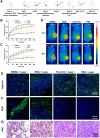GSH-responsive polymeric micelles-based augmented photoimmunotherapy synergized with PD-1 blockade for eliciting robust antitumor immunity against colon tumor
- PMID: 39238020
- PMCID: PMC11378416
- DOI: 10.1186/s12951-024-02813-w
GSH-responsive polymeric micelles-based augmented photoimmunotherapy synergized with PD-1 blockade for eliciting robust antitumor immunity against colon tumor
Erratum in
-
Correction: GSH-responsive polymeric micelles-based augmented photoimmunotherapy synergized with PD-1 blockade for eliciting robust antitumor immunity against colon tumor.J Nanobiotechnology. 2024 Oct 15;22(1):624. doi: 10.1186/s12951-024-02899-2. J Nanobiotechnology. 2024. PMID: 39402676 Free PMC article. No abstract available.
Abstract
Phototherapy is a promising antitumor modality, which consists of photothermal therapy (PTT) and photodynamic therapy (PDT). However, the efficacy of phototherapy is dramatically hampered by local hypoxia in tumors, overexpression of indoleamine 2,3-dioxygenase (IDO) and programmed cell death ligand-1 (PD-L1) on tumor cells. To address these issues, self-assembled multifunctional polymeric micelles (RIMNA) were developed to co-deliver photosensitizer indocyanine green (ICG), oxygenator MnO2, IDO inhibitor NLG919, and toll-like receptor 4 agonist monophosphoryl lipid A (MPLA). It is worth noting that RIMNA polymeric micelles had good stability, uniform morphology, superior biocompatibility, and intensified PTT/PDT effect. What's more, RIMNA-mediated IDO inhibition combined with programmed death receptor-1 (PD-1)/PD-L1 blockade considerably improved immunosuppression and promoted immune activation. RIMNA-based photoimmunotherapy synergized with PD-1 antibody could remarkably inhibit primary tumor proliferation, as well as stimulate the immunity to greatly suppress lung metastasis and distant tumor growth. This study offers an efficient method to reinforce the efficacy of phototherapy and alleviate immunosuppression, thereby bringing clinical benefits to cancer treatment.
Keywords: Hypoxic tumor microenvironment; Immune checkpoint inhibitor; Immunotherapy; Indoleamine 2,3-dioxygenase (IDO); Phototherapy; Polymeric micelles.
© 2024. The Author(s).
Conflict of interest statement
The authors declare no competing interests.
Figures







Similar articles
-
Nanoscale Reduced Graphene Oxide-Mediated Photothermal Therapy Together with IDO Inhibition and PD-L1 Blockade Synergistically Promote Antitumor Immunity.ACS Appl Mater Interfaces. 2019 Jan 16;11(2):1876-1885. doi: 10.1021/acsami.8b18751. Epub 2019 Jan 7. ACS Appl Mater Interfaces. 2019. PMID: 30582788
-
Photosensitizer-loaded gold nanocages for immunogenic phototherapy of aggressive melanoma.Acta Biomater. 2022 Apr 1;142:264-273. doi: 10.1016/j.actbio.2022.01.051. Epub 2022 Jan 31. Acta Biomater. 2022. PMID: 35101580
-
Preparation and effects of functionalized liposomes targeting breast cancer tumors using chemotherapy, phototherapy, and immunotherapy.J Nanobiotechnology. 2024 Sep 12;22(1):558. doi: 10.1186/s12951-024-02838-1. J Nanobiotechnology. 2024. PMID: 39267061 Free PMC article.
-
Phototherapy in cancer treatment: strategies and challenges.Signal Transduct Target Ther. 2025 Apr 2;10(1):115. doi: 10.1038/s41392-025-02140-y. Signal Transduct Target Ther. 2025. PMID: 40169560 Free PMC article. Review.
-
Light-based technologies in immunotherapy: advances, mechanisms and applications.Immunotherapy. 2025 Feb;17(2):123-131. doi: 10.1080/1750743X.2025.2470111. Epub 2025 Mar 3. Immunotherapy. 2025. PMID: 40032620 Free PMC article. Review.
References
-
- Fan W, Yung B, Huang P, Chen X. Nanotechnology for Multimodal Synergistic Cancer Therapy. Chem Rev. 2017;117:13566–638. - PubMed
-
- Chen J, Zhu Y, Wu C, Shi J. Nanoplatform-based Cascade Engineering for Cancer Therapy. Chem Soc Rev. 2020;49:9057–94. - PubMed
-
- Liu Q, Duo Y, Fu J, Qiu M, Sun Z, Adah D, Kang J, Xie Z, Fan T, Bao S, et al. Nano-immunotherapy: unique mechanisms of nanomaterials in Synergizing Cancer Immunotherapy. Nano Today. 2021;36:101023.
-
- Huang C, Wang H, Yang X, Yu Q, Wang H, Zhang L, Zhao Y, Zhu D. Cascade Carrier-Free nanoparticles forming in situ nanovaccines for synergistic Photothermal‐Immunotherapy of Cancer. Adv Funct Mater. 2024;34:2401489.
-
- Huang C, Zhang L, Guo Q, Zuo Y, Wang N, Wang H, Kong D, Zhu D, Zhang L. Robust Nanovaccine based on polydopamine-coated mesoporous silica nanoparticles for effective Photothermal‐Immunotherapy against Melanoma. Adv Funct Mater. 2021;31:2010637.
MeSH terms
Substances
Grants and funding
LinkOut - more resources
Full Text Sources
Research Materials

